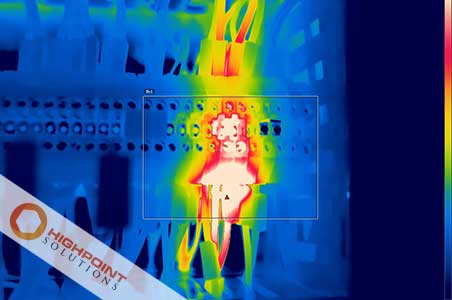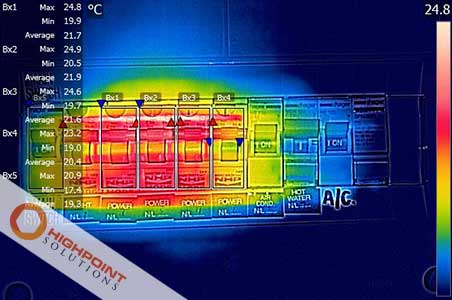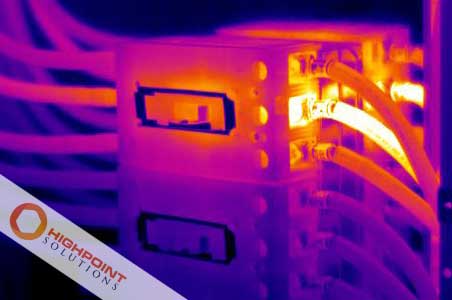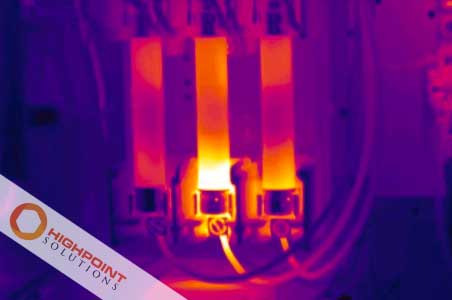
Thermal Imaging - Frequently Asked Questions
To help serve you better, we have put together a list of the most frequently asked questions related to thermal imaging. If you have a question that's not covered below please contact us.
The price of a thermographic inspection varies depending on location, access, time and volume of images taken. A thermographer can comfortably survey 50 pieces of equipment in a day, providing access is arranged. Generally, a one hour on-site inspection is $150.00 (plus GST). If a report is required then the price will be adjusted accordingly on a per hour basis. As a guide, 1.0 hour in the field requires approximately 2.0 hours for post-image processing, thermal tuning, image interpretation, analysis, and report generation.
Another way you could look at this question is, “Is it worth taking the risk by not having a thermal imaging inspection”?
Thermal imaging is a powerful, non-contact inspection method capable of identifying serious electrical or mechanical faults that could otherwise lead to large financial losses if left undetected. By using our nationwide thermal imaging services, you may even be eligible for reduced insurance premiums from your insurance company. Risk mitigation should be a focal point for any company as it creates a safer workplace for you and your employees/tenants. The ROI for is huge from a safety and financial perspective.
No, Although we recommend regular thermographic inspections as part of your preventative maintenance program, we don't lock in ongoing contracts. Saying that, once you use our services once and see the amazing benefits thermography has to offer, we are confident you'll become a long term partner with us.
Thermal Imaging is a special type of photography which has many uses. There is probably a very good chance that you have already heard about thermal imaging, however you might not be aware of what it actually is.
Thermal imaging is where the photographs or videos are made up of heat signatures rather than light. This means that you can see things that would otherwise be hidden and invisible. A thermal imaging camera records the intensity of radiation in the infrared part of the electromagnetic spectrum and converts it to a visible image.
Read more - click here
The thermal radiation and the infrared radiation are the same thing if the sources of the radiation have temperatures comparable to the room temperature.
In general, the two terms are different: the infrared radiation is defined by having the wavelength in the fixed interval 0.7 - 300 micrometers (a convention). While the thermal radiation of an object depends on its absolute temperature T. While any object at nonzero temperature emits at all wavelengths, the wavelength at which the emission is maximized is inversely proportional to the temperature of the source T in Kelvins.
Modern thermal imaging devices produce high resolution real-time thermal images of the infrared energy emitted from an objects surface. A certified thermographer will scan the electrical switchgear, looking for hot spots in the electrical components. If a hot spot is identified, the technician will capture the thermal image for further analysis, reporting, and future trending.
Today’s thermal imagers, which produce live images of the heat emitted from equipment, are rugged, easy to use and much more affordable than just a few years ago. This makes them highly practical and cost-effective solutions for everyday electrical maintenance. To use one, a qualified technician or electrician points the imager at the equipment in question, scans the immediate area for unexpected hot spots, then squeezes the trigger to capture a specific image. When the inspection is complete, the saved images can be uploaded to a computer for closer analysis, reporting and future trending.
Because most electrical equipment tends to get hot before they fail, infrared inspections are the preferred diagnostic method used to detect early failures in electrical systems and switchgear.
There are endless applications for thermal imaging, however the most common uses include;
Thermal imaging is used to evaluate heat loss from houses and buildings. It can also determine how effective the insulation in the building is, while highlighting any areas where there is missing or defective insulation. Water ingress leading to dampness in the gyprock or other building materials are easily identified using an infrared camera.
Electrical equipment tends to heat up before it fails, hiding from sight until a problem becomes “self-evident”. Fortunately, our high-spec thermal imaging cameras instantly make those hot spots clearly visible so you can catch them in time to investigate further, plan repairs, and get components fixed before they turn critical.
Infrared Thermographic imaging has proved to be a valuable tool in the monitoring of the performing, injured or recovering equine. The temperature differential between opposing body parts can detect inflammation in the body of humans and mammals. The increased heat caused by inflammation is easily detectable using a high resolution thermal imaging camera.
Police and Law Enforcement
- Police helicopters fitted with infrared imaging devices are used to help identify indoor cannabis hydroponics systems. The increased heat produced by the high powered grow lamps can be seen from above.
- Fugitives can be seen hiding under tree canopies in complete darkness as thermal imaging devices do not need a source of visible light to work; they detect infrared energy being emitted off the surface of an object.
- Slight variants in temperature can indicate hidden compartments in walls.
Read more about thermal imaging uses - click here.
Once you have supplied a list of equipment you require scanning, we will then book a time to conduct the thermographic survey. If we identify any serious thermal anomalies during our thorough on-site inspection we will notify you right away so immediate actions can be taken. On the completion of the thermographic survey we will deliver a comprehensive, easy to digest thermographic report. Hard copy and emailed PDF reports are supplied within 48 hours of the inspection. All our reports are highly accurate, easy to understand, and give you a quick snapshot of the current status of your electrical switchgear. Your comprehensive report will clearly highlight the severity of the fault, along with any necessary actions or repairs that should be attended to. Once repairs have been made to the faulty equipment or components, we will then conduct a follow-up thermographic scan to confirm the repairs.
Electrical surveys can identify poor connections, overloaded circuits, failing components or imbalanced loads. Any faults on electrical systems are expensive in terms of plant downtime, damage, loss of production or risk from fire. Annual thermographic inspections of your electrical switchboards will help protect your business operations from potential fire and costly damages. Just some of the reasons you should have a thermal imaging inspection include:
Maximise tool utilisation by preventing downtime.
Maximise asset utilisation by increasing reliability and uptime.
Reduced liability.
Reduced utility costs by increasing energy efficiency.
Reduced cost of maintenance programs.
Lower repair costs.
Prevent fires and catastrophic thermal events.
Enhance quality of product with process consistency.
Extend tool life and quality with baseline documentation.
"Go Green" by increasing efficiency and reducing waste.
Peace of mind knowing your workplace and employees are working in a safe environment.
Savings in insurance premiums from having an annual thermal survey conducted on your electrical switchboards.
Thermography standards in Australia are yet to be developed, however at Highpoint Solutions we conduct business under internationally recognised standards. We only implement proven thermographic inspection techniques and assessment processes. Although thermography standards don’t yet exist, there are standards set for the training and certification of technicians, instrument operation, electrical and mechanical inspections, including condition monitoring (CM) and structural systems.
In order to interpret the thermal images correctly the operator needs to know how different materials and circumstances influence the temperature readings from the thermal imaging camera.
The easiest way to interpret your thermal images is to have on of our certified technicians explain them in layman's terms through an easy to digest report.
Some of the most important factors influencing the temperature readings are:
Thermal conductivity
Different materials have different thermal properties. Insulation tends to warm up slowly, while metals tend to warm up quickly. This is called thermal conductivity. Difference in thermal properties in two different materials can lead to large temperature differences in certain situations.
Emissivity
To read correct temperatures, one important thing needs to be taken into account, and that is a factor known as emissivity. Emissivity is the efficiency with which an object emits infrared radiation. This is highly dependent on material properties. It is extremely important to set the right emissivity in the camera or the temperature measurements will be incorrect. At Highpoint Solutions, our thermal imaging cameras have predefined emissivity settings for lots of materials, and the rest can be found in an emissivity table. Furthermore, we are able to determine the emissivity of Any surface using various techniques which all certified thermographers are trained to do.
Reflection
Some materials, such as most metals, reflect thermal radiation much like a mirror reflects visible light. Reflections can lead to misinterpretation of the thermal image; the reflection of thermal radiation from the operator’s own body or from a light bulb might lead to a false temperature reading. The operator should therefore choose the angle at which the thermal imaging camera is pointed at the object carefully, to avoid such reflections. If the object’s surface material has a low emissivity and there is a large difference in temperature between the object and the ambient temperature, the reflection of incident radiation will influence the temperature readings from the thermal imaging camera. To solve this problem, our FLIR thermal imaging cameras have the option to set the apparent reflected temperature.
Indoor and outside temperatures
To detect missing or ill performing insulation using thermal imaging cameras there needs to be a difference between the temperature indoors and the temperature outside. It is often possible to do work with smaller temperature differences, but usually a temperature difference of at least 10 °C between the two sides of the wall is advisable.
Influences on the outside of a building
It goes without saying that direct sunlight can influence thermal readings, but sunlight can have long lasting effects as well. Direct sunlight and shadows might even influence the thermal pattern on a surface many hours after the exposure to sunlight has ended. Differences in thermal conductivity can also cause differences in thermal patterns. Brick changes temperature much slower than wood, for example. Wind can also influence the thermal data. Airflows cool down the surface material, lowering the temperature differences between hot and cold areas.
Heating and ventilation systems
External influences on surface temperatures can also be found indoors. Ambient temperature can influence the object surface temperature, but there’s another factor as well: climate control. Heating systems create temperature differences that can cause misleading thermal patterns. Cool air flowing from ventilators or air conditioning systems can have the opposite effect, cooling down the surface.
Influences on the inside of the building
Bookshelves, cabinets and pictures hanging on the wall can also change the thermal pattern. These examples of furniture and wall decorations have an insulating effect. If these things are taken away from the wall, that area of the wall will show up in the thermal image as being colder. This might be confused for missing insulation. For that reason it is advisable to remove items from the wall at least 6 hours before inspection.
Reflections from the surroundings
When scanning reflective targets, be sure to change your angle to minimize the reflections on the image. The reflection could be from your body heat, or some other heat source in the area, a piece of machinery, light bulb or a transformer. Reflections will give you incorrect data in the thermal image, and if not understood, it is a data error.
Being a leader in the thermography field, Highpoint Solutions deploy only the most advanced thermal imaging devices manufactured by FLIR. We use a broad range of thermal imaging devices for all types of applications. From electrical switchboards to high voltage transmission lines, we have a device to suit your needs.
In theory there should be no impact whatsoever other than a thermographer being present on site visiting each key electrical location. Providing you communicate with the technician and provide access to each location, there will be no impact on your productivity. Remember the benefits of thermal imaging? click here to read more.
There are many reasons not to do electrical testing and inspections, such as cost, inconvenience, or lack of knowledge. However none of these reasons will be accepted as a defence in the event that an accident or fire occurs. Aside from the threat of prosecution in the event of injury or death, surely the safety of your colleagues, employees, patients or belongings are reason enough to test and inspect electrical systems at work.

Maximise Production
Producing faster, better, more efficiently and at a lower cost. In order to reach these goals, industrial plants need to be running continuously: 24 hours a day, 365 days a year. Our Condition Monitoring services are designed to ensure maximum equipment uptime.

Proactivity - Key to Success
A proactive approach allows identification of warning signs and potential issues which can prevent early component failures. Optimum maintenance scheduling through the use of proactive Condition Monitoring (CM) is a key factor to your businesses success!

Predictive Maintenance
Where temperature is a key factor, IR Thermal Imaging is one of the best tools for predictive maintenance. Make Predictive Maintenance a key tool in your asset management plan.
REDUCING UNPLANNED DOWNTIME = HIGHER COST SAVINGS! = HIGH PROFITABILITY!









